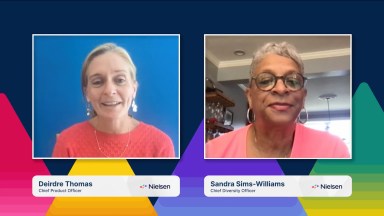
Digital ad spend is increasing. Digital ad formats are proliferating. Digital ad targeting is automating. Digital measurement is improving. Digital returns on investment (ROI) are proven.
All of which leads to an increasingly common question from clients: Should I just move to an all-digital plan? This question is quickly followed by others: Does it work? What do I need to know to be successful if I do move? What are the risks?”
“All digital” is a bold move for any marketer. Brands have been steadily increasing their digital ad spend as they get increasingly comfortable with digital advertising and measurement, but quitting linear TV entirely? That’s a big move with multiple factors to consider. Here are 10 questions to answer when considering taking the plunge.
1. How talented is my digital creative agency? Most large brands have years of experience with their agencies creating :30 and, to a lesser extent, :15 TV ads, and refining them through copy testing. They know what works, what doesn’t, how to measure and improve them, and are generally comfortable with the medium. Digital presents vastly more creative options, but with newer options typically comes less experience and confidence. Are you sure you have all the digital creative talent and expertise you need before making a move?
2. How important is video to my marketing efforts? Different brands and marketing strategies demand different expressive mediums. If your brand advertising strategy requires all video, or a lot of video, an all-digital plan can be problematic. Online video is generally more expensive than TV on a cost-per-thousand basis, so high-quality video inventory can be a significant limiting factor, especially if you need to achieve broad reach.
3. Can my digital plan achieve TV-like reach? Frankly, probably not. Achieving high levels of reach with an all-digital plan is challenging. TV plans can easily deliver unduplicated reach of 85%-90%. Nielsen Digital Ad Ratings show that the best digital plans struggle to exceed 60%. Achieving high levels of digital video reach is even harder. This is a critical issue, as studies generally show a linear relationship between reach and sales response. Give up reach, and you give up sales.
4. Can I effectively find my ideal audience? Yes. Digital offers big advantages over traditional TV in this regard. With digital advertising, you can buy audiences based on almost any variable – demographics, buyer behavior, intent, etc. You can even use your first-party customer data to build “look alike” models that will allow you to find similar (and therefore promising) digital audiences. It’s true that TV is becoming addressable, and campaigns are increasingly incorporating audience data beyond age and gender. For now, however, digital is the better choice for hyper-focused audience campaigns.
5. Will my digital ads actually be delivered to this audience? Only to a degree. Even if your ad is served to a human and is viewable, it needs to be delivered to the correct audience. Nielsen data on more than 30,000 digital ad campaigns shows that only about 60% of digital ad impressions reach the intended audience. The good news is that most digital publishers large and small now offer audience guarantees to ensure that your digital ad buy is really reaching your intended audience. Don’t go all-digital without audience guarantees.
6. Will my digital ads be viewable? Not nearly as reliably as you’d like. Numerous MRC-accredited viewability measurement tools point to the same conclusion: Generally, about 50% of digital ad impressions aren’t viewable. Of course, if an ad isn’t viewable, it will have no impact. If you’re going to go all-digital, your agency must address the viewability issue or you will wasting a good part of your media spend.
7. Will my digital ads be as effective as TV ads? Possibly. Moving out of TV and into digital raises a fundamental question: How effective are digital ads compared with traditional linear TV ads? Display ads are generally less effective in driving brand lift than TV ads. But online video ads are typically more effective than their linear TV counterparts. Moving from TV to an all-display digital plan will almost certainly depress your results. The key is to understand the mix of video and display in an all-digital plan and be sure that you’re not giving up overall effectiveness – but see point 2, above.
8. Can I optimize my digital plans in-flight? Yes. A big advantage of digital is the ability to measure brand lift or sales performance or both in flight, in close to real time – and make adjustments to optimize performance before the campaign ends. Rotating creative units based on performance, capping exposure frequency where response flattens out, and focusing spending on sites which drive higher lift are all feasible in digital. Brands that take advantage of real-time optimization routinely improve digital ad performance by as much as +30%.
9. Will giving up cross-platform exposure affect my ad performance? Maybe. Cross-platform ad exposure (e.g., the same person seeing both your TV and digital ads) drives greater brand lift than single platform exposure, even when adjusted for frequency. The same is true for digital video and display ads. What are you giving up by moving to all-digital? If you’re moving to all-display, you’re giving up some cross-platform-driven brand lift. If your digital plan is a mix of video and display, then you’re likely not giving up much (but see point 2, once again).
10. What’s the cost impact of moving all digital? There’s no simple answer to this one. As noted above, online video is generally more expensive than TV on a CPM basis, while display is usually cheaper. However, programmatic and real-time bidding capabilities give you vastly more control of how much you pay for audiences. Historically, TV provided more accountability with audience guarantees, but over the past several years, digital has quickly caught up.
So, what to do? What’s my advice to CMOs?
- Consider these 10 questions as a starting point.
- Now, think about your brand and business situation – any important questions unique to your brand that need to be considered.
How do your answers affect your expectations of a positive ROI from the move? The fundamentals of advertising success don’t change, whatever the medium. Reaching the right audience, generating brand lift and driving a customer reaction is what’s required for digital success, as with TV, radio and print.
There is, however, one last, big difference: Digital is vastly more complicated. To use a non-digital metaphor, there are more dials to turn and levers to pull to improve ad performance. The upside can be considerable. But there are also big holes to stumble into if you’re not careful. Don’t make a big move without asking – and answering – all these questions.



